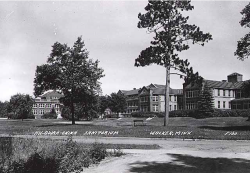Difference between revisions of "Minnesota State Sanatorium"
m (Added image gallery) |
M-Explorer (talk | contribs) m (Adjusted category to reflect status change.) |
||
| (One intermediate revision by one other user not shown) | |||
| Line 11: | Line 11: | ||
| closed = 2008 | | closed = 2008 | ||
| demolished = | | demolished = | ||
| − | | current_status = [[ | + | | current_status = [[Demolished Institution|Demolished]] |
| building_style = [[Cottage Planned Institutions|Cottage Plan]] | | building_style = [[Cottage Planned Institutions|Cottage Plan]] | ||
| architect(s) = Clarence H. Johnston Sr. | | architect(s) = Clarence H. Johnston Sr. | ||
| Line 45: | Line 45: | ||
[[Category:Minnesota]] | [[Category:Minnesota]] | ||
[[Category:Cottage Plan]] | [[Category:Cottage Plan]] | ||
| − | [[Category: | + | [[Category:Demolished Institution]] |
Latest revision as of 02:55, 7 November 2022
| Minnesota State Sanatorium | |
|---|---|
 | |
| Established | 1905 |
| Opened | 1907 |
| Closed | 2008 |
| Current Status | Demolished |
| Building Style | Cottage Plan |
| Architect(s) | Clarence H. Johnston Sr. |
| Location | Walker, MN |
| Alternate Names |
|
History[edit]
The Ah-Gwah-Ching Center, located about two miles south of downtown Walker, Minnesota, once was home to hundreds of tuberculosis patients who lived and worked on the property. The center opened in December 1907. Known then as the Minnesota Sanitorium for Consumptives, its primary purpose was to treat cases of tuberculosis. The facility was designed by state architect Clarence H. Johnston Sr., who also is known for creating the plans for many homes along St. Paul's historic Summit Ave. Originally meant to house 65 patients, by 1927 the facility had 300 patients, according to an article in the Walker Pilot newspaper. The facility still is licensed for 343 beds, but only staffs 155, according to the Minnesota Department of Human Services, when it closed. In June 2008 just 105 patients were housed at Aw-Gwah-Ching.
Soon after the opening of the sanatorium it became apparent that more than a single facility was needed to serve the state. Reported cases of tuberculosis rose from 1,471 in 1890 to 1,864 in 1900 and 2,270 in 1910. To meet this rising demand, in 1913 the facilities at Walker were supplemented by a system of county sanatoriums and the advisory commission was given the power to approve plans for them.
Perhaps the most impressive part of the center's history is its art collection. During the Depression, Geving said, lithographs, watercolors, wood sculptures and other art forms were created and put on display at Aw-Gwah-Ching as part of the Works Progress Administration's Federal Arts Project.
In 1957, the official name of the sanatorium was changed to the Minnesota State Sanatorium. After its closing in 1962, the sanatorium at Glen Lake (Hennepin County) was designated as the state facility for tubercular patients. That year, Aw-Gwah-Ching was converted to a state-owned nursing home for people with "challenging behaviors,"The facilities at Walker became the Ah-Gwah-Ching Nursing Home, a state institution for geriatric patients. Its last patients left early 2008 and it officially closed later that year.
Images of Minnesota State Sanatorium[edit]
Main Image Gallery: Minnesota State Sanatorium Image Gallery




